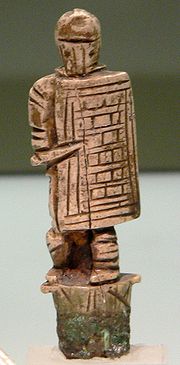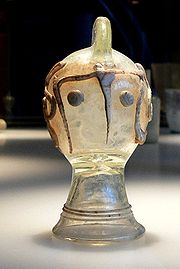
Secutor
Encyclopedia



Gladiator
A gladiator was an armed combatant who entertained audiences in the Roman Republic and Roman Empire in violent confrontations with other gladiators, wild animals, and condemned criminals. Some gladiators were volunteers who risked their legal and social standing and their lives by appearing in the...
in ancient Rome
Ancient Rome
Ancient Rome was a thriving civilization that grew on the Italian Peninsula as early as the 8th century BC. Located along the Mediterranean Sea and centered on the city of Rome, it expanded to one of the largest empires in the ancient world....
.
Thought to have originated around 50 AD, the Secutor ("Follower", from sequor "I follow") was armed similarly to the Murmillo
Murmillo
The murmillo was a type of gladiator during the Roman Imperial age. The murmillo-class gladiator was adopted in the early Imperial period to replace the earlier Gallus, named after the warriors of Gaul...
gladiator
Gladiator
A gladiator was an armed combatant who entertained audiences in the Roman Republic and Roman Empire in violent confrontations with other gladiators, wild animals, and condemned criminals. Some gladiators were volunteers who risked their legal and social standing and their lives by appearing in the...
, and like the Murmillo, was protected by heavy armour. A Secutor usually carried a short sword, a gladius
Gladius
Gladius was the Latin word for sword, and is used to represent the primary sword of Ancient Roman soldiers. Early ancient Roman swords were similar to those used by the Greeks. From the 3rd century BC, the Romans adopted swords similar to those used by the Celtiberians and others during the early...
, or a dagger
Dagger
A dagger is a fighting knife with a sharp point designed or capable of being used as a thrusting or stabbing weapon. The design dates to human prehistory, and daggers have been used throughout human experience to the modern day in close combat confrontations...
. The Secutor was specially trained to fight a Retiarius
Retiarius
A retiarius was a Roman gladiator who fought with equipment styled on that of a fisherman: a weighted net , a three-pointed trident , and a dagger...
, a type of lightly armoured gladiator armed with a trident
Trident
A trident , also called a trishul or leister or gig, is a three-pronged spear. It is used for spear fishing and was also a military weapon. Tridents are featured widely in mythical, historical and modern culture. The major Hindu god, Shiva the Destroyer and the sea god Poseidon or Neptune are...
and net.

The secutor wore a loincloth, and a wide belt (much like that of the retiarius). On his right arm, he wore a manica (a heavy linen or metal wrapping tied with leather thongs), and on his left leg, he wore an ocrea (a greave made of boiled leather or metal). He also carried a scutum
Scutum (shield)
Scutum is the Latin word for "shield", although it has in modern times come to be specifically associated with the rectangular, semi-cylindrical body shield carried by Roman legionaries.-History:...
(a curved rectangular shield) to protect himself.

